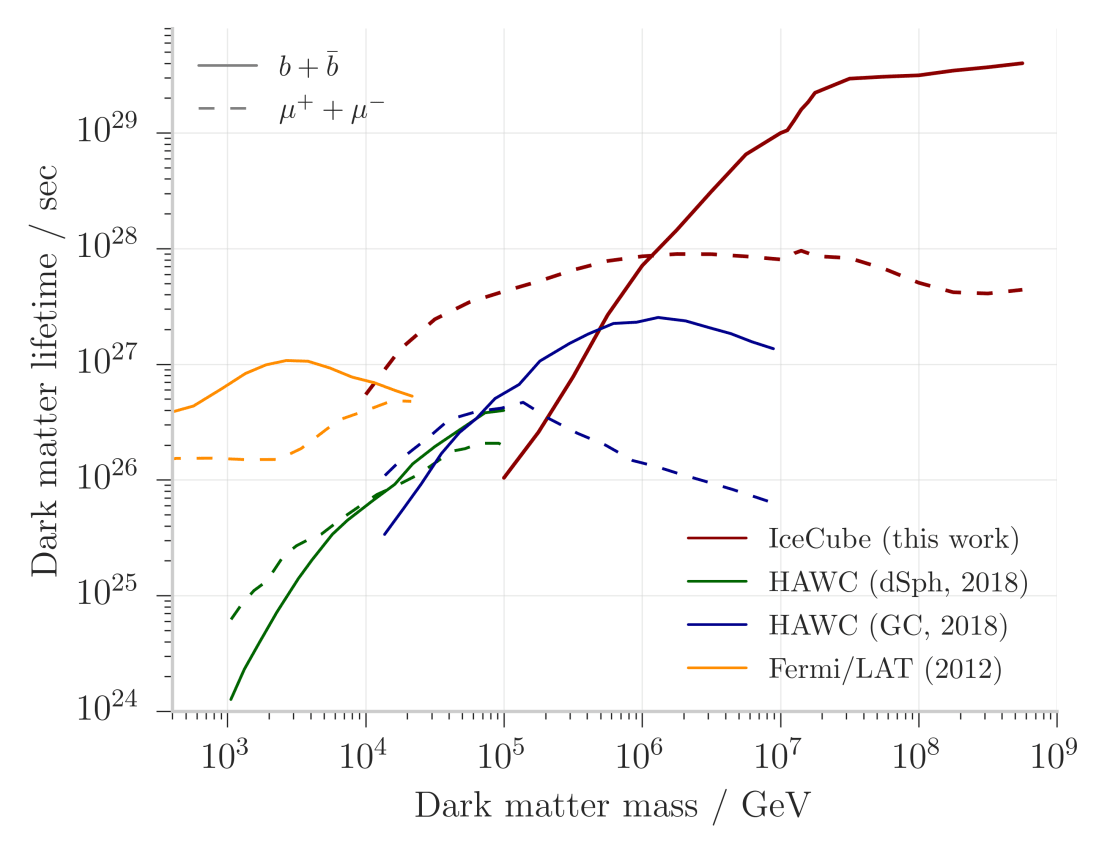The existence of dark matter was proposed to explain gravitational effects of objects such as galaxies that could not be described by the constituents of so-called “normal” matter—electrons, neutrons, and protons. But dark matter searches have so far been futile. A proposed solution is a new, heavy dark matter particle that is long-lived but not necessarily on cosmic timescales.
This scenario is especially interesting for IceCube because the decay of dark matter can produce high-energy neutrinos. And some models predict that some or all of the highest energy neutrinos seen in IceCube could be the result of such decay.
The IceCube Collaboration has tested a few of these models and found no evidence that the high-energy neutrinos can be attributed to the decay of heavy dark matter particles. This nondetection resulted in a new lower limit of 1028 seconds—about 10 billion times the age of the universe—for the lifetime of dark matter particles with a mass of 10 TeV or above. The paper summarizing these results has just been submitted to the European Physical Journal C.

Following the current understanding of fundamental interactions, all matter is unstable—even protons are expected to decay, although we might never see the decay of one since its lifetime is at least 1024 times the age of the universe.
Relic particles that may make up galactic and extragalactic dark matter could have lifetimes short enough to allow us detect the high-energy neutrinos that they would inevitably produce. Indeed, several theoretical models ascribe the cosmic neutrino signal detected by IceCube at TeV-PeV energies to the decay of heavy dark matter.
IceCube searched for heavy dark matter in two independent measurements—one using six years of muon-neutrino tracks from the Northern Hemisphere and the other using two years of all-flavor neutrino cascades from the full sky—and found that if dark matter neutrinos exist, then only 1 in every 10 billion dark matter particles could have decayed by now. These results also prove that IceCube is a high-precision particle detector that can rule out, or at least constrain, dark matter theoretical models.
IceCube data has been fitted with different combinations of theoretical predictions for dark matter and a diffuse astrophysical component. “Using both tracks and cascades, data favors a small but nonsignificant contribution from dark matter,” explains Jöran Stettner, a graduate student at RWTH Aachen University in Germany and main author of this work. “However, adding a dark matter contribution does not significantly improve the description of the observed astrophysical neutrinos,” adds Stettner
This nondetection is used to set the strongest bounds to date on the minimal lifetime of dark matter particles with masses above 10 TeV. “To explain that we have not seen neutrinos from the decay of heavy dark matter, the lifetime of the hypothetical particle has to be much larger than the age of the universe,” says Hrvoje Dujmovic, a graduate student from Sungkyunkwan University in Korea and also main author of this paper.
+ info “Search for neutrinos from decaying dark matter with IceCube,” IceCube Collaboration: M. G. Aartsen et al., European Physical Journal C (2018) 78: 831, link.springer.com, arxiv.org/abs/1804.03848